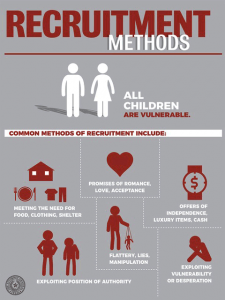Human trafficking involves the use of force, fraud, or coercion to obtain some type of labor or commercial sex act. Every year, millions of men, women, and children are trafficked worldwide – including right here in the United States. It can happen in any community and victims can be any age, race, gender, or nationality. Traffickers might use violence, manipulation, or false promises of well-paying jobs or romantic relationships to lure victims into trafficking situations.
Language barriers, fear of their traffickers, and/or fear of law enforcement frequently keep victims from seeking help, making human trafficking a hidden crime.
Traffickers use force, fraud, or coercion to lure their victims and force them into labor or commercial sexual exploitation. They look for people who are susceptible for a variety of reasons, including psychological or emotional vulnerability, economic hardship, lack of a social safety net, natural disasters, or political instability. The trauma caused by the traffickers can be so great that many may not identify themselves as victims or ask for help, even in highly public settings.
Cases of trafficking have been found all across the world. In addition, cases have been reported in all fifty states of the United States.
Los Angeles is one of the top three points of entry into this country for victims of slavery and trafficking. Trafficking occurs in a triangle from Los Angeles, California to Las Vegas, Nevada, and back to Sacramento, California.
Victims of sex trafficking can be women or men, girls or boys, but the majority, at more than 80% of the victims, are women and girls.
- There is not one consistent face of a trafficking victim. Trafficked persons in the US can be rich or poor, men or women, adults or children, foreign nationals or US citizens. Some are well-educated, while others have no formal education.
- While anyone can become a victim of trafficking, certain populations are especially vulnerable. These may include: undocumented migrants; runaways, homeless and other at-risk youth; and oppressed, marginalized, and/or impoverished groups and individuals. Traffickers specifically target individuals in these populations because they are vulnerable to recruitment tactics and methods of control.
Safety Tips
If you feel like you may be in a trafficking situation, please consider how to plan for your safety. Below are some basic safety tips. If you would like to discuss creating a safety plan, call 209-588-9305, or contact the National Human Trafficking Hotline at 1-888-373-7888 or through 711 (TTY).
- Keep all important documents and identification in your possession at all times.
- Keep important numbers on your person at all times, including the number of someone you feel safe contacting if you are in trouble.
- Make sure that you have a means of communication (cell phone, phone card), access to your bank account, and any medication that you might need with you at all times. Have an extra phone charger on you.
- Document any unwanted contact by your trafficker (calls, texts, emails, showing up at your work/home) and save any voicemails/texts/emails that are threatening in nature.
- Have a special signal (lights flicking on and off, code word, code text message, etc.) to use with a trusted friend/relative/neighbor to notify them that you are in danger or a person/situation is suspicious.

